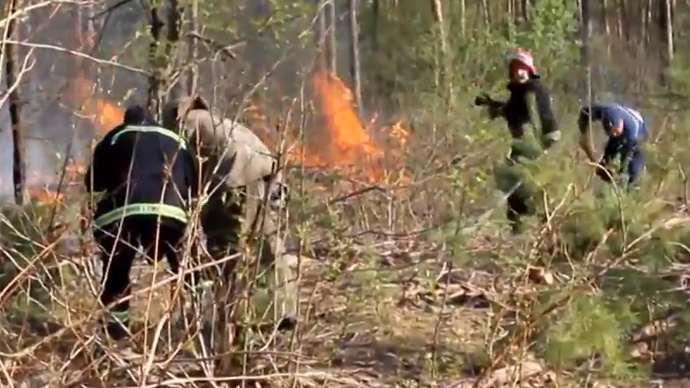Fire near Chernobyl site alarming, ‘radiation respects no boundaries’

A forest fire near Ukraine’s Chernobyl nuclear site may cause problems for communities a long way from the area as the dispersal plumes can transport radiation further to the north, nuclear safety expert John Large told RT.
RT:How dangerous is the situation in your opinion? Do you agree with ecologists who say the smoke will spread the radiation?
John Large: I spent some time in Ukraine in 2006 and I assessed the Chernobyl situation interviewing about 30 scientists and engineers who were working on the aftercare of Chernobyl. Brush fires and forest fires were the greatest concern in terms of the means by which you can disperse a secondary radiological impact from the original dissipation that occurred in 1986... What you have in Chernobyl in the exclusion zone and the further way you have an area that has been abandoned for farming, abandoned for management. That means you’ve got lots of brush and young wood growing out of control. Let me assess that – a big fuel load to have a fire. That means that the biological load is very high, so the radiation particles can be dispersed. Take down the chemistry as well. The chemistry is the way in which the strontium and cesium from the radioactive strontium and cesium from the reactor are bound here, and of course the elevated temperature of the fire and plus all the plume and aerial dispersion - means that could transport it hundreds of kilometers, particularly to the north, to Belarus. So there are more problems here for communities that are long way away from the site. What I had hoped was that the Ukrainian officials would have had in place firefighting capacity greater than they normally would have at any other area of Ukraine, because it certainly needs to be protected not just now but in the longer term as well.
READ MORE: Forest fires heading for Chernobyl nuclear plant – Ukraine Interior Ministry
We know that Ukraine is cash-strapped. There was a responsibility for its neighbors, Russia, the EU, not Belarus as much because it’s in an even worse financial situation, but there was a general responsibility to protect this area from another bout of radioactive dispersion.
RT:What lessons can be learned from this particular incident then to make sure that the brush and the forest doesn’t catch light again, or if it does, to make sure that site is secured?
JL: It is not the reactor, it is not the location of the reactor that is the problem - it is the dispersal plumes from the original accident - that is the problem. If there are radioactive materials on the ground now and then it’s engulfed by forest fire maybe 40-50 km away from the reactor. But that deposited radioactivity is re-suspended into gas, blown high into the atmosphere by the heat of the flames, and then of course it settles somewhere else. And it maybe those communities to the north that are not prepared to have this new radiation plume and deposition and fallout come down on their communities.
RT:Do you think there should be a common international strategy and response for situations like this?
JL: We’ve seen recently with Chernobyl, with Windscale in the 1950’s in the UK, and particularly now with Fukushima that the radiation doesn’t respect any international boundaries. So an international effort is required for this type of catastrophe, all potential catastrophes. I would have thought that the EU or Russia would have healed their scars over this and got together and put some efforts and resources into controlling this and make sure it doesn’t happen again.
MORE:
The statements, views and opinions expressed in this column are solely those of the author and do not necessarily represent those of RT.
The statements, views and opinions expressed in this column are solely those of the author and do not necessarily represent those of RT.












